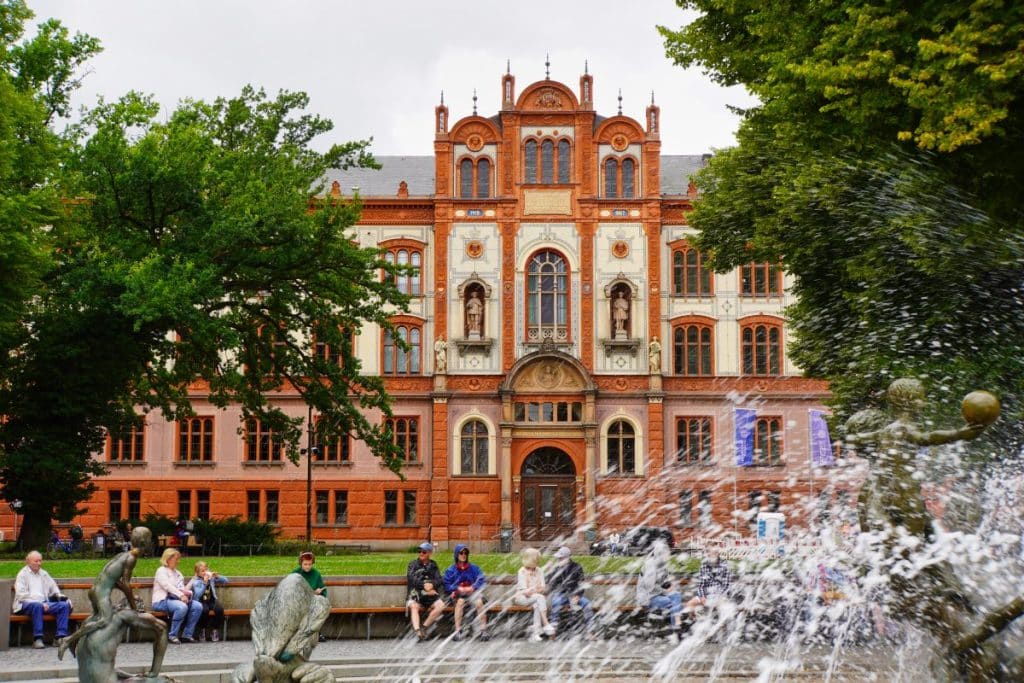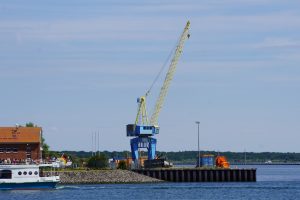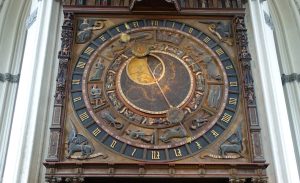m standing on a viewing platform on a cliff overlooking the River Eo, which forms the border between Galicia and Asturias here. On the Galician side is the small coastal town of Ribadeo, which I will visit for a short city walk.
We looked around a bit and some places during our tour through the old town of Rostock particularly impressed us. You can follow the route very well on the map.
The starting and ending point of our little tour is the Neuer Markt in Rostock.
Old Town of Rostock: Neuer Markt
The Neuer Markt is almost square and, in my opinion, quite unattractive. A large paved area, with some art, little greenery and the tram that runs past the edge of the square. Only when the regular weekly market is on the square does it seem lively.

Rostock once consisted of three sub-towns: Old, Middle and New Town. Each area had its own market square, its own church and its own town hall. The Neuer Markt belongs to the historic Mittelstadt, the associated town hall stands on the east side of the square and St. Mary’s Church rises in the background.
In medieval Rostock, the economic centre of the middle town was located on the Neuer Markt. Around the square, rich upper-class citizens built beautiful gabled houses. The court was held in the town hall and the pillory once stood in the middle of the square.
Little of the original design of the Neuer Markt can be seen today. Almost all the buildings were destroyed or damaged in air raids during the Second World War. On the north side of the square, only 3 of 10 houses remained. On the east side, the town hall with two adjoining gabled houses have been preserved, only the western side of the square remained a fairly large contiguous ensemble of houses.

After the war, the city decided not to completely rebuild the square; they even demolished the last houses on the northern side of the square to create a monumental stretch for political rallies.
Today, the western side of the market is the real eye-catcher of the square. Here are beautiful gabled houses that look old and historic at first glance. But not all the houses are really old. For example, the houses numbered 9/10 were built in the 1950s. Visually, they replicate the war-damaged predecessor buildings quite well. Other houses, however, are really very old. For example, the narrow green gabled house with house number 11 was remodelled in baroque style at the end of the 18th century, and the yellow corner house has a medieval core with a classicist façade.
For all those who are looking for house numbers 19 to 28 at Neuer Markt… these were on the north side of the square. The original house numbering was retained and since the houses no longer exist, the house numbers no longer exist either.

Fountain of the joy of life
The city stroll through the old town of Rostock first took us along the pedestrian zone to the Fountain of Joie de Vivre, which is located on the University Square. But stop! Don’t forget to buy a typical GDR soft ice cream first. The small shop is somewhat hidden in the pedestrian zone.

The fountain, which has been vigorously discussed by the people of Rostock, has been there since 1980. It shows 16 sculptures of people and animals. The life-size people are naked and stand very close together. This is certainly one reason why the people of Rostock have given the fountain the name Porno Fountain.
Today the fountain is a popular meeting place. Children play in the small water fountains and no one is bothered by the nakedness of the people anymore.

I walk around the fountain for a while, looking at the animal figures that are nevertheless very true to life.
University of Rostock in the old town of Rostock
The impressive main building of the University of Rostock stands directly behind the fountain and the adjacent green space. This is the third oldest university in Germany.
In 1419, the dukes Johann IV and Albrecht V of Mecklenburg founded the first university in the Baltic region with the council of the Hanseatic city of Rostock. The foundation was financed almost exclusively by the citizens of the city.

Initially, there was a faculty of law, a faculty of philosophy and a faculty of medicine in existing buildings in the city. Initially, there was no theological faculty, which was only approved by the Pope in 1432.
In the 15th and 16th centuries, the University of Rostock was one of the most important universities in Germany, with about 500 students from northern Germany, Holland, Scandinavia and the Baltic states. In 1569, the university library was founded, which today has a book collection of 2.2 million volumes.
The beautiful main building on Universitätsplatz was built in 1866/70 in the neo-Renaissance style. Over the years, many scientists and researchers who are famous today, such as Heinrich Schliemann, studied here.
Kröpeliner Gate
Following the pedestrian zone, we reached the Kröpelin Gate. A large and imposing city gate that stood as one of the four large gates in the Rostock city fortifications from 1270.
With the construction of the city’s fortifications, a two-storey city gate was initially built, which was extended over the years by 5 storeys and thus to a height of 54 metres. The gate stood on the road leading to Lübeck and Wismar and its size alone was intended to show travellers the importance of the Hanseatic city of Rostock.

After the city had expanded beyond the medieval ring of walls, the gate lost its function as a city gate. It became a showpiece building of the city. Today it no longer has any connection to the city wall, but you can see quite clearly from the masonry where the wall joined the gate.
Unused, the gate does not stand at the end of the pedestrian zone; today, various exhibitions and events take place in the gate.
Directly behind the gate, there is easy access to Rostock’s ramparts. This was once part of the city’s fortifications. I discover remains of the city wall and the typical bastions. It is a beautiful green area that invites you to take a relaxing walk.
Once you have arrived at the hay bastion, you can take a short detour to the Holy Cross Monastery and the monastery garden. There is also a museum about the city’s history. We took a closer look at the museum and followed in the footsteps of my ancestors.
However, we continued along Wallstraße until we reached the crossroads at Steinstraße.
Rostock House of Estates
The Rostock Higher Regional Court stands at the crossroads. Originally, the imposing building was Rostock’s Ständehaus.

The red brick building was erected from 1889 to 1893 in only four years of construction. Numerous ornaments and turrets adorn the magnificent façade, which initially served as a parliament building for the Knights and Lands of Mecklenburg-Vorpommern.
I particularly like the four bronze figures of the Dukes of Mecklenburg Johann Albrecht I, Friedrich Franz II, Georg I and Christian II, which are arranged to the right and left of a large coat of arms on small ledges of the main façade. The coat of arms on the Rostock House of Estates bears the motto: “Per aspera ad astra” (Through difficulties to the stars).

Unfortunately, it is not possible to enter the courthouse, but it is said to be very impressive inside.
Stone Gate
Right next to the Ständehaus is the Stone Gate, which today stands on a traffic island. This gate also once belonged to Rostock’s city fortifications and was one of the city’s main gates.
It is assumed that the first Stone Gate was originally constructed similarly to the Kröpelin Gate. After not-so-peaceful disputes between Rostock and Schwerin, the duke at the time had parts of the fortifications and also the Stone Gate ground down and used the stones to build a fortress (located in today’s Rose Garden).


In 1574-77, the citizens of Rostock bought the right to rebuild their fortress wall, including the Stone Gate. They had the Stone Gate built in the style of the Dutch Renaissance.

The gate shows two different sides. The city side is much more elaborately designed and is intended to present the wealth of the city. An inscription shows the city’s election slogan: “Sit intra te concordia et publica felicitas” – Within your walls reign concord and public welfare. Two lions bear the Rostock coat of arms. The field side of the gate is much simpler. Here, embrasures to the outside represent the city’s defences. There was a drawbridge that could be raised in the event of an attack. This no longer exists today.
From the stone gate, a beautiful path leads us further along the former city wall to the Kuhtor.

Kuhtor
Initially called the Old Stone Gate, the town gate lost its importance when the (new) Stone Gate was built. The gate, which is one of the oldest buildings in the town, was now only used to drive the animals to the pastures nearby. This explains the name “Kuhtor” (cow gate). The former defence tower was later used as a residential building for many years, and today the literature promotion group holds readings there.

n my opinion, the gate is quite impressive. Almost square with a height of 3 metres and a wall thickness of 2 metres, it looks very massive. The base and foundation still show very clearly what massive stones the gate was made of.
If you want to take a break here, there is a great café with homemade cupcakes in the immediate vicinity.
From there, the walk took us through Rostock’s old town towards the city harbour.
Monk’s Gate
Rostock was also protected from attacks towards the water. At the end of the Große Mönchenstraße is the last surviving beach gate of this section of the fortress. In front of this gate was Rostock’s beach, which had served the city as a harbour since the Middle Ages. The beach bailiff lived on the upper floor of the gate.

The first monk’s gate is mentioned in records in 1316. Over the years, it has been adapted several times to the latest architectural style. During the last renovation in 1990/92, the classical design with the stepped attic was taken up again. An Empire vase crowns the building.
After passing the gate. We reached the Rostock city harbour.
Rostock city harbour
Rostock’s city harbour is located on the southern bank of the Warnow River and is only a small area of the large harbour area.
As a Hanseatic city, Rostock was involved in Hanseatic trade. The city harbour was the transhipment point for many goods and 7 beach gates in the city wall alone provided access to the city from the Kaufmannsbrücke (landing stage).
After the decline of the Hanseatic League and the shift of world trade to the Atlantic, the city harbour lost importance. The great city fire of 1677 further worsened the situation. It was not until 1850 that business in the port revived. It was not long before Rostock had the largest merchant fleet in the Baltic region with almost 370 ships.

The port received an additional upgrade with the connection of a harbour railway to the railway network. We passed an old railway station, which is now a restaurant. Here, old wagons still stand on the last rails and remind us of that time.
Since 1991, the typical harbour facilities have been gradually dismantled and so today you can stroll directly along the Warnow and stop off at one or two restaurants. But a little harbour feeling has been preserved. Some interesting ships are moored on the shore and the excursion boats to Warnemünde depart from there.
I was impressed by the replica of an old harbour treadle crane (1780). With this type of crane, loads are lifted by winding a rope onto the axle drum of a treadwheel. In Rostock, this crane was not primarily used for loading and unloading ships. It was used to erect the masts of the brigs that were built in Rostock until the 1980s.

I also find the two huge portal cranes and the bridge crane imposing. What huge steel constructions that could certainly lift enormous weights.


At the end of our little tour of the harbour, we were drawn to some of the museum ships anchored in Haedgehafen. You are not allowed to enter them, but from the shore you have a good view of the ships. Some of them are even said to still be in working order.

From the city harbour, the path led us through the old town of Rostock, criss-crossing back to the Neuer Markt.
Back on the New Market
Our tour of Rostock’s old town ends where we started, on the Neuer Markt. Here we finish with a place that not every visitor to Rostock knows: the queue at Rostock’s town hall.

We had to search a bit to find the snake, because it lives small and inconspicuous on a pillar at the front of the town hall. Where does it come from? That seems to be its secret to this day. What is known, however, is the following:
The baroque town hall porch dates back to 1727/29. There are oral traditions dating back to the beginning of the 19th century that tell of the existence of the reptile, which at that time wrapped itself completely around the pillar.

Then the reptile seems to have been forgotten. It was only when the façade of the town hall was painted in 1927 that the snake reappeared in the stories surrounding the town. Now, however, it was placed between two pillars. The war, environmental influences and other interventions changed the appearance of the concrete snake. Over time, it looked more and more like an eel. At the end of 1993, the animal was replaced by a weather-resistant bronze snake, which disappeared from its mount after only a few years. Since 1998, there is now a new sculpture on the column again, which combines a mixture of a snake and an eel.










Leave a Reply